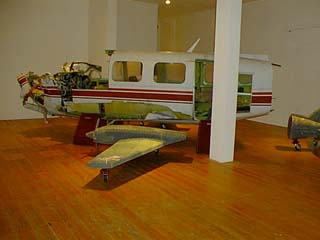So,
nothing to direct to a site on this collaborative group of artists
who dragged the fuselage of a crashed small passenger plane into 200
Gertrude Street. And yet a lot of context which informs the work C.O.T.I.S.
Mortality, survival, legality, emergency, dollars are all terms prompting
a relationship with the issues raised by this peaceful, dead aeroplane
in a gallery.
The
perverse shrine constructed by C.O.T.I.S. (aka Kit ) is a combination
of the "readymade" (or more correctly: Industrial junk) fuselage and
some lovingly made "Phantom limbs".
Wing and tail sections which, due to their obviously diminished scale,
disconnectedness from the body and upholstery unsuited to the utility
we expected of the body before its demise, might be pregnant with
satire or desire.. we will have to wait and see.
The
upholstery reminds of Hadrian Pigotts "Instrument of Hygiene (case
1)", from 1995 where the artist placed a porcelain washbasin, some
copper plumbing fittings and two cakes of soap into a plushly red-velvet
upholstered, fitted case. The case might have held some unusual musical
instrument until it displayed it's contents of fetish.
At least
two more British artists connect with C.O.T.I.S in quite intimate
ways. The first comparison is perhaps a little obvious: the carcass
of a plane which, as much as any mechanical entity can, had died-
and the lovingly made superbly detailed "Dead Dad" (1996-7) sculpture
of a nude adult male, by Ron Mueck .
The
other example I wanted to mention is Jonathan Parsons "Carcass", a
dissected map (all the roads have been removed from the original map
with what must have been surgical precision) of "Greater London",
displayed in an acrylic case. Parsons "Carcass" is fragile beyond
belief- an entire circulatory system of a great entity is a challenge
between gravity and millimetre-wide strips of tenacious paper.
Ok,
you get something of an idea how it all fits together, but I've not
yet mentioned two features of the work: the first is a soundtrack,
the second aerial photography of crash-site images printed on the
upholstery used to cover the wing and tail-sections.
The
sound is inconsistent, emerging from a concealed source inside the
fuselage. We cannot place it exactly but it is familiar. The catalogue
informs us that it constitutes fragments of "Black Box" recordings.
Sometimes they appear to play backwards as if this could reverse the
final moments of disasters that terminate in eerie silence after the
sound of impact subsides.
The
catalogue lists the 10 pre-impact recordings of plane crashes referenced
by C.O.T.I.S. . I will not repeat them all here except to say the
last comments by flight crews share the normal human dimensions of
expressions. We have the fatalist: "that's it.. I'm dead", the inevitable
"oh fuck me" and the uncomprehending: "What's going on now?".
The
irregular sounds emanating from this aeroplane body accompany the
visible debris: the twisted seats and the wires slithering from the
instrument section like spilled guts. Continuing my scrutiny of the
interior I notice small personal items of the demised occupants :
a cotton bud here, a toothbrush wedged between vinyl and aluminium
there.. nothing of great significance and yet informed by the fatal
history of this relic.
With
this history in mind it is easy to see a convergence between the private
and the public elements of the crash. The upholstery on the wings
and tail sections reinforces this with its printed imagery comprising
aerial images of crash-sites. Debris locations are highlighted with
white marks like the body outlines of victims in old detective films.
At this
stage our attention is directed at the evidence. The evidence of a
crash and how we encounter it involves a complex process of mediation
between privilege (authority), convention (social moires) and the
collective quest to establish causality.
Crashes,
and other disasters responsible for loss of life are endlessly picked
over for evidence of causality. Modern investigators emulate the poor
of Calcutta who scrutinise the terrain for scraps of food (means of
survival). Evidence is collected so that the "body" can be re-constituted
and analysed for the weakness that caused the disaster.
This
essentially functionalist approach tends to define things in terms
of cause and effect but even at its most successful, cannot reconcile
the ‘inner' nature of the event . The obscenity of random in an ordered
society is enough to make anyone nervous.
In a
society where we have successfully sanitised our experience of death,
where most of the dying is in controlled environments such as slaughterhouses
and hospitals, or virtual on a screen or embedded in text, a plane/car
crash occurs outside the specified locations for death and becomes
a macabre but brief monument to the failure of a system which has
wrapped itself in mechanical and electronic aids for survival.
The
relationship between the technology disaster and art has been examined
across a variety of media, ranging from Andy Warhol's "Disaster" images
(mid 60's) to J.G. Ballards "Crash" (1975) and Mark Pauline/SRLs techno-destructo-fetish
events during the '80s and '90s.
The
"C.O.T.I.S." work by "Kit" adds food for thought..... will continuing
technological augmentation realise the extropian dream or will we
simply become more vulnerable?
As we
hurtle into the next millennium we have to pass 2000. Good luck!
View
images from the exhibition:


*Note:
"200" Gertrude Street , just like "1999" is only one digit away from
2000. ©Werner Hammerstingl, Melbourne, 1999